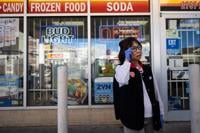Illegal immigration pumps roughly $2 billion into the Colorado economy, while costing taxpayers nearly $200 million annually, according to an analysis by The Denver Gazette.
Extrapolated from the research of prominent social scientists and state agencies, the findings — $1.9 billion in economic boost and $188 million in direct expenses a year— surprised community leaders and immigration advocates alike.
Broadly speaking, advocates on both sides of the issue view illegal immigration as a net benefit or a net cost. But it's both a complex and emotional issue for which Americans do not hold neatly monolithic views.
Any cost-benefit analysis is bound to have limitations, and the cost or benefit can be uneven, depending on the location and the timeframe. Near the border, El Paso in Texas has a distinct experience from Denver, some 600 miles away. In addition, such analyses explore macro levels, but don't capture the dynamics on the interpersonal level.
Some assumed these workers benefit the local economy, but did not expect such a large economic windfall.
“We knew it would be a net positive for the city,” said Denver Mayor Mike Johnston.
Johnston added: “These are exactly the kind of hard-working residents you want. They contribute, like every other citizen of the city.”
Removing the roughly $2 billion these workers earn annually and contribute to the state’s economy, Johnston said, would be “catastrophic” to Colorado.
Others, such as the Federation of American Immigration Reform, or FAIR, estimate a higher number of immigrants in the country — and in Colorado — and offer a larger cost, after looking at a slightly different set of data, that they insist outweigh the benefits.
The Denver Gazette analysis of economic benefits does not take into account the income taxes or sales taxes workers’ pay, nor does it include the money they have contributed to but cannot withdraw from Social Security. But it does include indirect benefits, such as the purchasing power of their earnings. The costs, meanwhile, are direct and static — the incarceration expenses, for example, do not include the tangible and intangible costs of crimes, such as policing or legal costs.
As Denver marks its one-year anniversary since 90 immigrants were dropped off downtown at Union Station and left to wander in the cold looking for shelter, The Denver Gazette explored what the economic impact could be on a state hundreds of miles from the international border with Mexico.
As of Sunday, the city had received 35,588 immigrants — roughly the size of Englewood, a suburb of Denver — from South and Central America. The response to the humanitarian crisis unfolding at the U.S. border and in The Mile High City has cost a staggering $36 million, and counting, to temporarily feed, house and transport these newly arriving immigrants. Despite federal and state grants, Denver taxpayers have assumed the bulk of these costs.
“While the expense has been great, we should also note that immigrants have a long, proud and documented history of contributing to our economy,” Jon Ewing, a Denver Human Services spokesperson, said in an email to The Denver Gazette.
Denver Human Services has been managing the humanitarian response since the city lifted its emergency declarations.
“Individuals arriving in Denver are not seeking a handout but a hand-up,” Ewing said.
'Benefits greater than costs'
While officials have estimated the majority of these immigrants do not intend to stay in Colorado, the City and County of Denver has purchased bus, train and plane tickets for nearly half of the new arrivals.
“There’s room in the analysis to say this is the bare level of potential,” said Joel Carlman, executive director of Project Renew, an effort by Denver Community Church (DCC) focused on transformative learning, generosity and service.
The group was among the first to welcome — as they believe their Christian faith demands — the immigrants in the Denver region. The church coordinated with Annunciation House in El Paso, Texas, to receive two busloads of about 100 immigrants last November and December, before the influx had registered with city leaders.
“There are some of these people who have nothing and there’s a lot showing up with nothing, but who have left a lot behind,” Carlman said.
Social scientists have verified a similar analysis conducted in Southern California, saying the approach to calculating the benefit by estimating the earnings of immigrants is reasonable. But they cautioned that any appraisal makes assumptions about the size of this largely hidden population, their employment and earning power.
The Denver Gazette’s analysis relies on these best assumptions and comes with this important caveat: none of the estimates included the unprecedented spike in immigration this past year.
This is because the most recent estimate on the size of the unauthorized immigrant population in Colorado is from 2021.
The Denver Gazette interviewed a group of day laborers gathered off Federal Blvd and 20th on Saturday, Dec. 11, 2023. The group discussed increasing job scarcity and competition for work and firmly stated that their immigration was to improve their families' respective financial securities.
A Metropolitan State University of Denver economist did not dispute The Denver Gazette's finding a large economic contribution of immigrants to Colorado compared to the public social costs.
“I do think your analysis is correct, in terms of the benefits of undocumented immigration,” said Alexandre Padilla, professor and chair of the Economics Department at MSU.
Padilla added, “The benefits are far greater than the costs.”
As an economist, Padilla said the “numbers do matter,” although calculating the contributions is “always difficult.” Padilla also said the methodology provides a good starting point.
In addition to the direct advantages of increasing the size of the labor force, working jobs Americans eschew and paying federal, state and local taxes, Padilla said workers without authorization also provide indirect benefits. For example, low-skilled immigrants who clean houses or provide child and elder care services enable residents — particularly highly-skilled women — to remain in the labor market, which in turn affects tax contributions.
“They do pay a lot of taxes,” Padilla said. “Often people assume if you’re an undocumented immigrant that they don’t contribute to taxes and that’s not correct.”
In 2013, the Social Security Administration analyzed the financial contributions of workers without authorization, finding immigrants paid $13 billion in payroll taxes in 2010 alone.
‘Draining resources, threatening way of life’
Critics of illegal immigration, however, remain unconvinced, and some maintain the The Denver Gazette's analysis of the costs are low.
“All of this points to the reason why we have immigration laws in the first place, to prevent this situation,” Ira Mehlman, a FAIR spokesperson, said of the costs. “When you open the border and allow millions to enter the country illegally, it comes with responsibilities.”
Mehlman said he believes the cost of immigration outweigh the benefits, citing a FAIR analysis that includes U.S. born children to immigrants, which more than doubles Pew’s estimate of this population. Notably, the FAIR analysis estimates taxes paid, not income earned.
The group, for example, estimated that the number of immigrants residing in Colorado without authorization is 278,000, and the total cost to state taxpayers more than $1.4 billion. All told, the group estimate that illegal immigration costs American taxpayers $182 billion and provides $31 billion in tax contributions — at a net cost of $151 billion.
"FAIR believes that every concerned American citizen should be asking our government why, in a time of increasing costs and shrinking resources, it is spending such large amounts of money on individuals who are not authorized to be in the United States," the group said in its report. "This is an especially important question in view of the fact that the taxes paid by illegal aliens offset very little of the enormous costs stemming from their presence in the country."
Based in Washington D.C., FAIR seeks to “restore common sense border controls” and reduce overall immigration levels to roughly 300,000 a year, according the organization’s website.
This would significantly reduce the numbers currently being seen at the southern border with Mexico.
Fiscal year 2023 saw more than two million apprehensions at the southwest border — which runs from San Diego to Brownsville, Texas — U.S. Customs and Border Protection data shows. The number of apprehensions has quadrupled since 2018, which saw roughly 404,100 illegal crossings.
Mehlman and others blame President Joe Biden, rather than the inaction of Congress.
“It is a humanitarian crisis largely the making of the Biden administration,” Mehlman said.
He added that the $187.9 million in state-tracked costs — with the exception of public education — sounded low.
Illegal immigration has long been a politically divisive issue in this country, with lawmakers on both sides of the aisle blaming the other for the inaction of Congress while agreeing a comprehensive solution is warranted.
U.S. Sen. Michael Bennet, a Democrat who was part of the “Gang of Eight,” a bipartisan group of senators who wrote a sweeping immigration bill in 2013 that ultimately died in the House, said the immigration system is "broken, putting immense strain on migrants and the communities across Colorado receiving them.”
“We have to reform our immigration system to honor our traditions as a nation of immigrants and our commitment to the rule of law, and that’s something I’m working toward in Washington,” he said.
Weighing in on social media, U.S. Rep. Lauren Boebert called the surge in multiple posts on X, the social media platform formerly known as Twitter, an unsustainable “invasion” of immigrants who “are draining our resources and threatening our way of life.”
“It’s time to come together and secure our country’s border,” Boebert said in an Oct. 13 post. “The situation has grown totally out of control!”
‘I think it’s more’
Immigration advocates have long believed this unauthorized work force buoys the economy with their cheap labor. Some were astounded by the financial contribution the workers make to the local economy.
"Wow," said Mateos Alvarez, executive director of the Aurora Economic Opportunity Coalition.
Formed in 2006, the Aurora Economic Opportunity Coalition offers a day laborer program that serves roughly 600 immigrants.
Gov. Jared Polis — who was criticized earlier this year by the mayors of New York City and Chicago for sending the immigrants who arrived in Denver to their cities — requested the methodology and then declined to comment on The Denver Gazette’s analysis.
To calculate the nearly $190 million cost, the newspaper used the three big budget items researchers study: health care, incarceration and education. (Immigrants without authorization to live in the U.S. do not qualify for federal health care programs, except for emergency care.)
With the exception of public education in Colorado, these are outlays reported by the state agencies. Every student in the United States — regardless of immigration status — is guaranteed a public education since the landmark U.S. Supreme Court decision in 1982. Subsequently, the Colorado Department of Education does not track students’ immigration status.
The newspaper’s analysis relied on national studies by Pew Research Center on the size and demographic characteristics — whether working adults or school-age children — of the unauthorized population in Colorado, estimated at 160,000 in 2021.
Based in Washington D.C., the Pew Research Center is a nonpartisan think tank that provides data on social issues, public opinion and demographic trends in the United States.
To tabulate the roughly $1.9 billion in the economic benefits, The Denver Gazette multiplied the estimated size of Colorado’s population without work authorization (about 74% of the total) by a yearly salary — assuming a minimum wage job — and subtracted 10%, the amount most immigrants send in remittances abroad to support their families.
The remittances sent home mean 90% of their incomes stay in the local economy.
That total was roughly $3.3 billion.
But because these workers often earn 35% less than those authorized to work, The Denver Gazette deducted roughly $1 billion from the tally.
“I think it’s more,” said Denver Public Schools Board of Education Director Xóchitl Gaytán said of the contributions of immigrants. “I know that it’s more and I know that our undocumented community is contributing a whole lot more to society than they are taking away.”
More than four decades ago, Gaytán crossed the Rio Grande — the water waste deep — as a 3-year-old with her then-pregnant mother. She became a U.S. citizen 18 years later under a sweeping immigration bill signed into law by former President Ronald Reagan in 1986.
Gaytán, who still identifies with “the undocumented community,” vividly recalls hiding as child from “la migra” with her two brothers in a broom closet while her mother cleaned offices downtown. She called the nation’s immigration system “awful.”
‘There’s no more work’
Opinion polls have found three-quarters of Americans believe workers without authorization fill the jobs U.S. citizens do not want. And with an unemployment rate last month in the United States at 3.7% and 3.3% in Colorado — economists consider full employment 5% or less — some insist there's plenty of work to go around for everyone.
A recent morning in Denver offered a more direct view of the situation.
Earlier this month, about a half a dozen mostly young immigrant men stood in 19-degree weather and 2 inches of snow before the sun rose on Federal Avenue, hoping a vehicle would swing by and offer them a job.
No U.S. citizens joined them.
All the day laborers do not have work authorization, which means they frequently rely on jobs that pay under the table.
These day laborers told The Denver Gazette that the influx of immigrants had driven down the amount money they can earn.
Jesus Martinez, who is originally from Durango, Mexico, said with an uncomfortable laugh in Spanish that he doesn’t want any more immigrants to come to Denver “because there’s no more work.”
The day labor market, Martinez said, is too saturated with immigrants looking for work. Unable to find work, many have already left Denver, Martinez said.
“There are a lot of people who have lost their faith and patience,” said Martinez, 35.
Martinez added, “There are too many people and not enough work.”
Day laborers like Martinez often pick up odd jobs cleaning houses, working construction and yard work to earn money.
Early in the humanitarian crisis, Denver officials decided to provide temporary housing and transportation to immigrants seeking to embark on a new life elsewhere in the U.S.
But that is proving tricky.
Even for immigrants with a pathway to legally reside in the U.S., the wait to receive work authorization can take months. And because temporary housing is only available for up to 37 days for families and two weeks for single adults, many opt to work as day laborers in the underground workforce.
For the past month, Antonio Mendoza, a Venezuelan immigrant, has slept in a friend’s car, unable to find steady work.
“This would end if the government would provide work authorization,” Mendoza, 34, said in Spanish.






















































 Your Privacy Choices
Your Privacy Choices